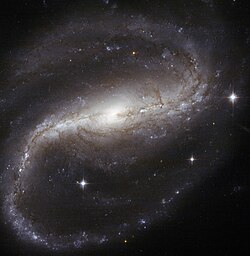astro.wikisort.org - Galaxia
NGC 7479 es una galaxia en la constelación de Pegaso. Su magnitud aparente es de 11,6 y su brillo superficial 13,5 mag/arcsec2. Fue descubierta el 19 de octubre de 1784 por el astrónomo William Herschel.
| NGC 7479 | ||
|---|---|---|
 | ||
| Datos de observación (época J2000.0) | ||
| Tipo | SB(s)c | |
| Ascensión recta | 23h 04m 56.6s | |
| Declinación | +12° 19' 22" | |
| Distancia | 105 millones de al | |
| Magnitud aparente (V) | 11,6 | |
| Tamaño aparente (V) | 4,1' × 3,1' | |
| Constelación | Pegaso | |
| Características físicas | ||
| Magnitud absoluta | - | |
| Radio | - | |
| Otras características | ||
| - | ||
| Otras designaciones | ||
UGC 12343 / PGC 70419 | ||
Es una galaxia espiral barrada de tipo SB(s)c con estructura muy asimétrica. Destaca su brillante y larga barra central en la que se está produciendo una elevada tasa de formación de estrellas,[1] sobre todo hace 100 millones de años,[2] además de un brote estelar compacto en su núcleo.[3] Se encuentra a unos 105 millones de años luz de la Tierra.
Estudiada en ondas de radio, NGC 7479 muestra un chorro de materia de longitud 12 kiloparsecs, doblado respecto a la galaxia que se cree pudo haber surgido debido a la colisión y absorción de una galaxia menor[4] hace 300 millones de años,[5] cuyos restos parecen hallarse en la barra galáctica;[6] otros estudios también que puede estar evolucionando bien a un tipo más temprano en la secuencia de Hubble, bien para convertirse en una Galaxia infrarroja luminosa.[7]
El 27 de julio de 1990 se observó una supernova (SN 1990U) en esta galaxia.
Referencias
- The H-alpha emission of the spiral galaxy NGC 7479.
- Star Formation Properties in Barred Galaxies(SFB). I. Ultraviolet-to-Infrared Imaging and Spectroscopic Studies of NGC 7479
- Compact Starburst in the Central Regions of Seyfert Galaxies
- Radio continuum jet in NGC 7479.
- The O/H distribution in NGC 7479: evidence for a minor merger event.
- NGC 7479: a case study.
- Ver referencia 2
Véase también
- Lista de galaxias
- Lista de objetos NGC
Enlaces externos
На других языках
[de] NGC 7479
NGC 7479 ist eine Balkenspiralgalaxie vom Hubble-Typ SB(s)c im Sternbild Pegasus am Nordsternhimmel. Sie ist schätzungsweise 114 Millionen Lichtjahre von der Milchstraße entfernt und wird als Starbust- und Seyfert-2-Galaxie klassifiziert.[en] NGC 7479
NGC 7479 (also known as Caldwell 44) is a barred spiral galaxy about 105 million light-years away in the constellation Pegasus. It was discovered by William Herschel in 1784. Supernovae SN 1990U and SN2009jf occurred in NGC 7479. NGC 7479 is also recognized as a Seyfert galaxy and a LINER undergoing starburst activity not only on the nucleus and the outer arms, but also across the bar of the galaxy, where most of the stars were formed in the last 100 million years.[2] Polarization studies of this galaxy indicate that it recently underwent a minor merger and that it is unique in the radio continuum, with arms opening in a direction opposite to the optical arms.[3] This feature, along with the asymmetrical arms of the galaxy and the intense star formation activity are attributed to a merger with a smaller galaxy.[2] This galaxy is similar in both size and morphology to the barred spiral NGC 1300.- [es] NGC 7479
[ru] NGC 7479
NGC 7479 (другие обозначения — PGC 70419, UGC 12343, IRAS23024+1203, MCG 2-58-60, KARA 1004, ZWG 430.58, KUG 2302+120) — спиральная галактика с перемычкой (SBc) в созвездии Пегас.Другой контент может иметь иную лицензию. Перед использованием материалов сайта WikiSort.org внимательно изучите правила лицензирования конкретных элементов наполнения сайта.
WikiSort.org - проект по пересортировке и дополнению контента Википедии